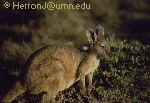They added, when available, turtles, mussels, crabs, shellfish,
many fish varieties and eels, aquatic birds and on occasion dingoes. All
meat was cooked before it was eaten. Water, sometimes sweetened with honey
was their only cold beverage. Hot tea-like drinks brewed by boiling water
with different kinds of leaves.
 Kangaroo, main source for
many needs.
Kangaroo, main source for
many needs.
WOMEN gathered the small food items and also assisted if necessary, the men trapping and hunting the larger animals. They used rocks or stones to ground the grass seeds for making flour, made dilly bags (string bags - string was made mostly from human hair and the sinews of animals). Women worked in groups the young helping the old. They had digging sticks, some had wooden shovels. Coolamons, the early version of the esky,( some made from bark, some from wood) were used to store food gathered till needed. Stone axes and bone awls, small spears with several prongs used for fishing and as cooking tools.
MEN hunted in a group although sometimes alone. Hunting was done in they very early morning or at night if the occasion warranted it. They made and used tools, stone axes, chisels, picks, hammers, waddies, spears, spades, woomeras, boomerangs, bone knives and awls. They made nets for fishing - some wide enough to reach right across the stream, snares and ropes. Dugout canoes and bark canoes were used in fishing.
On the coast the Aborigines possessed a highly specalised
technology for fishing and gathering. Inland they relied on hunting, trapping
and knowing how to remove toxic components from plant foods.
Published August 1997 ©